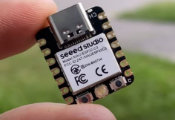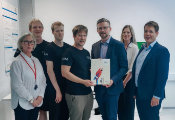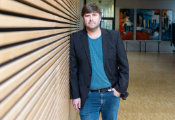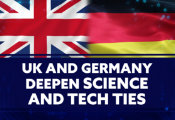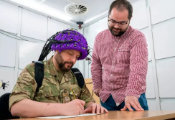Quantum Partnership Yields Scalable Control for Future Computers
SYDNEY, Australia, June 26 2025 -- Diraq and Emergence Quantum today announce technology that effectively reduces the size of the circuits required to run a silicon-based quantum computer, paving the way for more quantum information to be packed into a smaller footprint.
The milestone, published in Nature, is a crucial step towards integrating Diraq’s silicon ‘quantum dot’ technology with the mature processes of the semiconductor industry to achieve utility-scale quantum computers that can tackle problems with true societal and commercial value.
Quantum bits (or ‘qubits’) must be held at cryogenic temperatures, very close to absolute zero (–273.15 °C), to preserve their information. But they also need to be controlled and measured by complex electronics built from the complementary metaloxide semiconductor (CMOS) circuits found in laptops and smart phones.
Unlike qubits, these circuits are usually designed to work at room temperature, not at cryogenic temperatures. And if they are placed close to the qubits, they can heat them, degrading their performance. The control system can be separated from the qubits by long cables, but the millions of qubits required for practical quantum computing render this solution impossible.
Emergence Quantum has solved this challenge by designing ‘cryo-CMOS’ technology that functions at millikelvin temperatures, and together, Diraq and Emergence have now shown that this cryo-CMOS control circuitry does not compromise the performance of Diraq’s qubits.
Diraq’s founder and CEO, Professor Andrew Dzurak, said, “This advance offers Diraq a means of precise control without degrading qubit quality. It’s a key piece of the quantum-computing puzzle, and one that will accelerate our progress towards a machine that can solve the kinds of problems that are unthinkable with today’s computers.”
The research began as an academic endeavour between the University of Sydney and UNSW Sydney, in collaboration with Diraq. Publication of the paper in Nature comes shortly after the formation of Emergence Quantum, a new venture founded by Professor David Reilly and Dr Thomas Ohki at the University of Sydney, formerly part of Microsoft. The partnership between Diraq and Emergence Quantum has been cemented by Diraq’s recruitment of Dr Samuel Bartee, Reilly’s former student.
Bartee said, “It’s extremely exciting to be part of this work, to be involved in the development of such powerful technologies, and to sit in this hotspot of quantum computing research — Sydney really is a remarkable place for a quantum engineer to be at the moment.”
Diraq’s qubit technology is the ideal testbed for Emergence Quantum’s cryo-CMOS system. Last year, Diraq published a paper in Nature showing that its qubits can operate with high fidelity at 1 degree above absolute zero. This deviation from zero might seem small, but it has a remarkable impact on the possibilities for control, because it relaxes the tight heating constraints imposed on other qubit materials.
With these ‘hot qubits’ in hand, and Emergence Quantum’s cryo-CMOS control solution to minimize additional heating, Diraq is positioning itself to scale up to the millions of qubits required for practical quantum computing.
Reilly said, “Our team has long realized the need to more tightly integrate qubits with control systems, and now with Emergence Quantum, we are positioned to deliver real hardware solutions to researchers and companies across the quantum landscape. We want to catalyze the scaling of quantum technologies.”
The fact that Diraq’s technology is inherently compatible with the CMOS industry makes it easier to integrate innovations like Emergence Quantum’s circuitry. It also minimizes the investment required to realize quantum computing’s extraordinary potential by leveraging the decades of research and trillions of dollars already spent on CMOS R&D.
The ultimate goal is a computer like no other — one capable of accelerating progress in crucial areas such as drug discovery to enhance global health, and the design of innovative materials that can combat climate change.



